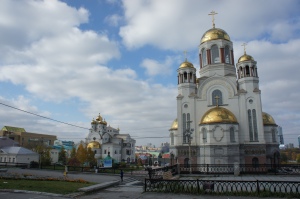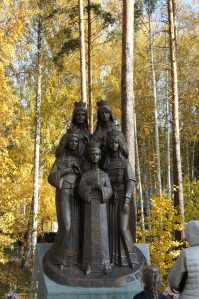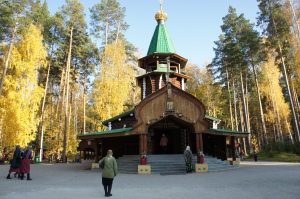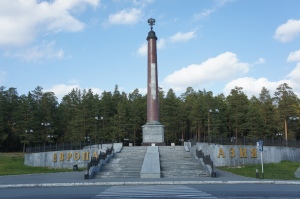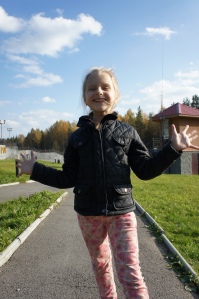We were met off the train by Natalie, our friend Paul’s sister, and her husband. Yet again, it was very early in the morning, so we were very thankful we didn’t have to make our own way! They had a car and so during our stay, Natalie very kindly drove us round to visit the sights of Yekaterinburg. Their apartment was in a Soviet style block – again, not looking so appealing from the outside because of all the concrete, but inside the flat was lovely.
That first day, we visited the church on the blood, which was built fairly recently on the site where the Romanov family were assassinated on 17th July 1918.
Nicholas II was the last tsar of Russia. Many people in Russia were unhappy as they felt the country had become impoverished and unstable under his rule; they had lost a war with Japan (1904-5) and millions of lives were lost in the war against Germany that started in 1914. He was forced to abdicate following the 1917 February Revolution, and he and his family were shunted round from place to place, until the Bolshevik Party (who were extreme Marxists) moved them to Yekaterinburg in April 1918. There they stayed at the house of a local engineer. The leader of the Bolsheviks, or the Red Army, was Vladimir Lenin. Supporters of the old regime were known as the Whites, and as the White army approached Yekaterinburg, the Bolsheviks panicked, thinking the royal family might be rescued, and ordered their execution. The family were taken to the basement of the house and shot – Nicholas II, his wife and their five children – four daughters and one boy – and their servants. A horrible turn of events, especially killing all the children as well, although you can see the cold logic of it all, and it does seem like many people died unnecessarily under his rule. They have since been made into saints of the Russian Orthodox Church. The reason for this is complicated and obviously controversial, given his reputation as a weak ruler, which many felt led to the uprising and put the lives of his family at risk. However, they were known to be a pious family and he was reputed to be kind in his private life and a good father and husband. The Russian Orthodox Church within Russia have canonised the family as ‘passion bearers’. This is separate from martyrdom, as they did not die for their religion, but resigned themselves to death in a Christ-like manner. It certainly is all very confusing! This cathedral had golden onion domes and a beautiful statue of the family outside.There are photos of them as well; they were a really handsome family. Inside, their remains are enshrined in an opulent room with lots of gold leaf and ornate designs. People were lighting candles at the altars and the general atmosphere was quite sombre and reflective.
Natalie has two children – a daughter, Anna, who is 8 (and an expert at origami!), and a son, Jene (I have spelt that wrong!), who is 17. We didn’t see much of Jene, but we spent a lot of time with Anna and were able to do our usual thing of behaving like big children! We had bought Anna some juggling balls at the cathedral, and when we met them for lunch, she was very excited about them and spent a good amount of time practicing (and throwing them at us!). We tried Uzbekistan cuisine – it was super tasty, herby and spicy, but not especially hot; lots of lamb dishes and grilled meats and delicious lamb pasties called samsa.
That afternoon, we visited a monastery that had been built in honour of the sainted Romanov family. It was out in the countryside in a forested area; a series of attractive wooden buildings interspersed between the birch trees.
The autumn colours of gold, red and orange were beautiful in in the clear afternoon light, and the contrast against the bright blue sky was gorgeous. There were several church like buildings of differing heights; most were built with logs, so the buildings blended well with the woodland. I imagine that without the tourists, it would be a perfect tranquil location for monastic reflection! Natalie and I had to wear our hoods up so our heads were covered and because we were wearing trousers, we had to get a skirt to wrap around us. All the skirts were red; I’m not sure if this was of any significance. Inside one of the churches, the monks take it in turns to read aloud religious text – I’m not sure whether they were prayers or scripture, but there has to be a monk reading it 24/7. I’m not sure if the monk we saw had only just started or not, but he didn’t seem to be losing his voice at all!
We were lucky enough to hear the bells being rung when we were there – apparently it only happens once a week. From what we could see at the top of the bell tower, there was a row of smallish bells with ropes attached and a monk would stand in front of them and pull on the ropes, playing in a rhythmical pattern. The sound was reminiscent of cow bells; softer and more tinkly than English church bells.
That evening, just before sunset, we took a trip up to the top of a 54 story building from where we had fantastic views across Yekaterinburg. The city was larger than I had thought; most of the buildings are modern, but there are a few golden onion domes dotted around, some parks and in the distance, lakes.
Sunday was spent visiting the fine art museum, which as well as the usual paintings and china displays, had a room dedicated to sculptures from the Kasli mines in the Urals. These were made from iron, which had been painted black, and historically there had been a collaboration between the smiths who worked the iron and artists and sculptors, so that with this sharing of skills, extraordinarily detailed pieces were produced. They would often have functions, so were not purely ornamental. Art was combined with practicality, so even mundane household items would become things of beauty. But they were also really heavy, so a lot of them were paperweights!
Yekaterinburg is in Asia. Later that day, Natalie drove us to the Europe-Asia border, and we amused ourselves walking from one continent to the other and back again.
On our way back we stopped at the house Natalie and Andrei are having built in the countryside. It will be great when it’s finished. We had one dinner there and then their friend, Alexei, invited Luke, Anna and I over to meet his mother. She had cooked us a second dinner! We were already stuffed, but it looked amazing, so we squeezed in a second one. She had grown all the vegetables herself, had picked the wild mushrooms and she also gave us a drink of wild berries in sugared water. She gave us a jar of mushrooms to take back with us. Alexei had built his house himself – he worked as an architect in Yekaterinburg. He was passionate about Russian culture, and seemed quite nationalistic, but also seemed genuinely excited to meet us and talk to us about his country. During dinner there, he turned off the lights and put on a music video of some sort of Russian folk power rock band – a lady in traditional dress wandering through forests singing in a powerful mystic sort of way, with much pounding of drums and flailing of arms at campfires. Something like a mediaeval Evanescence? It was a novel, but good experience. As guests in people’s homes, we have found Russian people exceptionally welcoming. However, our lack of Russian language skills is a big stumbling block for us when we are out and about and really limits our ability to socialise.
On our last full day in Yekaterinburg we travelled by tram all the way across the city to one of the parks. It took us over an hour to get there though and so we didn’t have much time to enjoy it. There were lots of tits (I think they were great tits!) and squirrels. The squirrels were very inquisitive and used to being fed by people; one ran up Luke’s leg, but he didn’t have anything to offer it. We tried to take photos but they were so quick I kept missing them! I will never make wildlife photographer of the year, unless what they’re after is the blurred backside of a squirrel.
That evening we bid a sad goodbye to Anna, who I think was upset to be losing her silly companions and Natalie drove us to the station. They had been so kind to us and we had managed to buy a bunch of flowers and write a card in Russian to thank them (Google translated, so probably quite badly expressed!).
